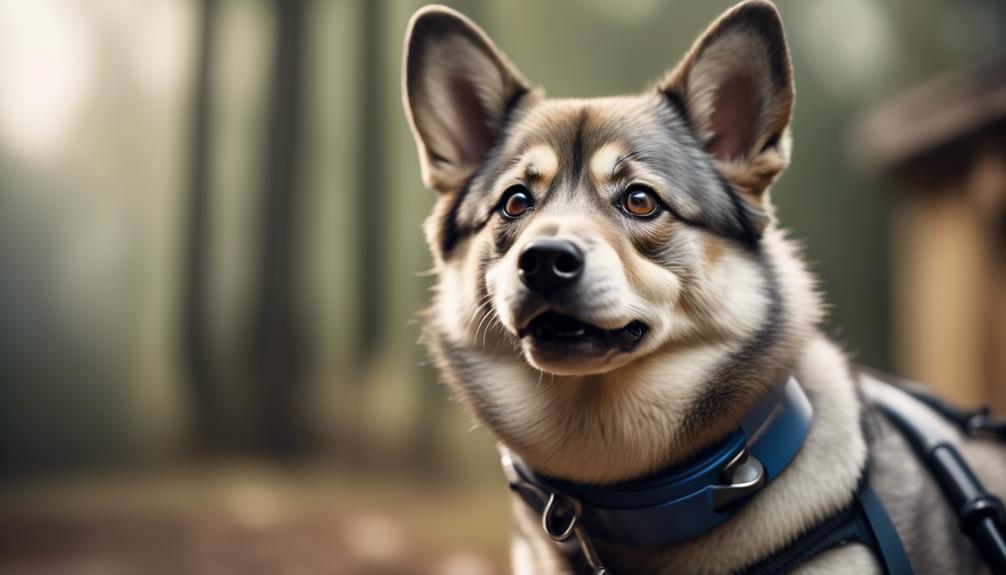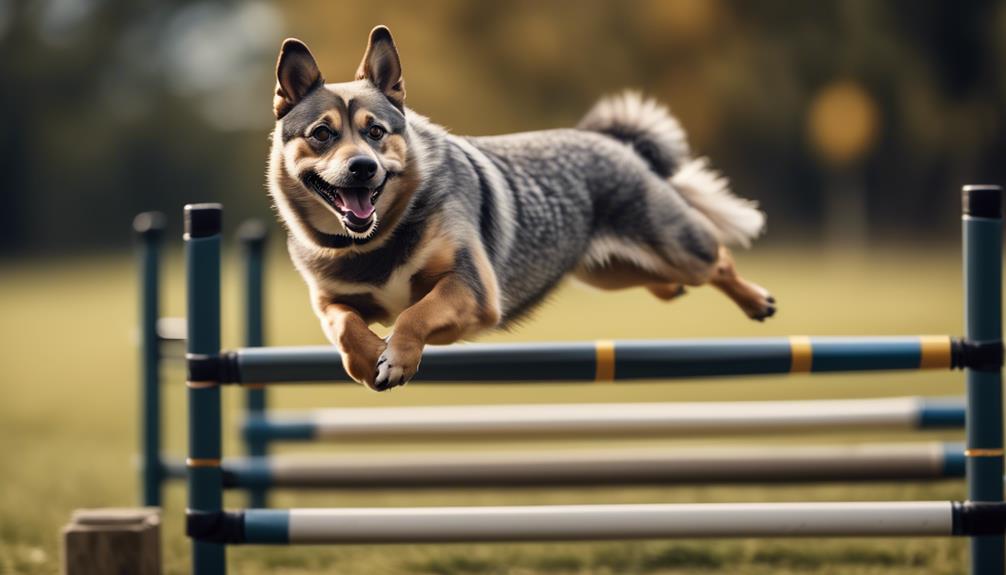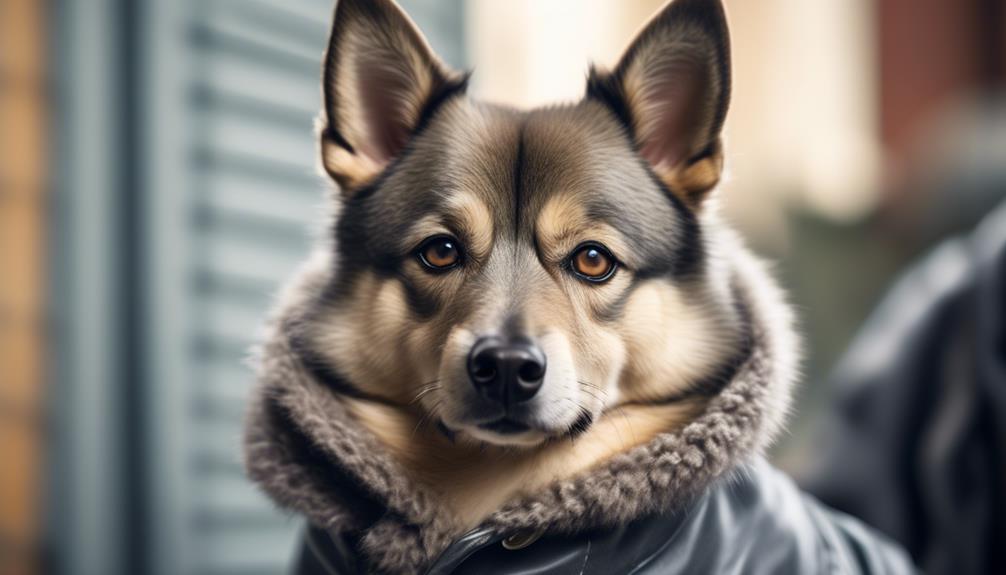
Searching for a sensational and steadfast canine companion? Look no further than the Swedish Vallhund, a captivating breed with a captivating history.
With their striking appearance and adaptable nature, these dogs have much to offer. But what sets them apart from other breeds? What makes them a perfect fit for your lifestyle?
In the following discussion, we will explore the origin, characteristics, and qualities that make the Swedish Vallhund an exceptional choice for those seeking a loyal and loving four-legged friend.
So, without further ado, let’s embark on an enlightening journey into the world of the Swedish Vallhund.
Key Takeaways
- Swedish Vallhunds are adaptable and can thrive in apartment living, regardless of their small size.
- Training and socialization should start early to ensure good behavior with strangers, children, and other animals.
- Vallhunds are generally healthy but can be prone to certain conditions, so choosing a reputable breeder with up-to-date health clearances is important.
- Vallhunds usually love children but may have herding instincts to nip, so proper supervision and teaching children to approach dogs properly is necessary.
Origin and History
The Swedish Vallhund dog breed has a rich origin and history in Sweden. These small herding dogs have been around for centuries, serving as trusted companions and working partners to Swedish farmers. They were originally bred to herd cattle, guard the homestead, and even catch vermin.
The Vallhund’s compact size and agile nature made them well-suited for herding in the rugged terrain of Sweden. Throughout history, these dogs proved their worth by being versatile and adaptable, handling various tasks on the farm.
Today, the Swedish Vallhund is still cherished in Sweden and has gained popularity in other parts of the world. Their unique appearance and incredible intelligence continue to captivate dog enthusiasts everywhere.
See another Dog breed profile.
Taiwan Dog Breed
Size and Weight

Swedish Vallhunds come in a small size and weigh between 20-35 pounds for males and 20-30 pounds for females. Despite their small stature, they are sturdy and muscular dogs. Their size makes them suitable for various living situations, including apartments. Here is a table showcasing the size and weight of Swedish Vallhunds:
| Gender | Size | Weight (pounds) |
|---|---|---|
| Male | Small | 20-35 |
| Female | Small | 20-30 |
Their compact size allows them to adapt well to apartment living, but it’s important to prioritize other qualities such as being quiet, low-energy, and well-mannered. Swedish Vallhunds are known for being affectionate, playful, and great with children and other pets when properly socialized. So, regardless of their small size, they can make wonderful companions in any living environment.
Breed Group Classification

When classifying the Swedish Vallhund breed, it’s important to consider its distinct characteristics and traits. Here are three key points to understand about the breed group classification:
- Herding Group: The Swedish Vallhund belongs to the herding group. This means that they have a natural instinct to gather and control livestock. They are known for their agility, intelligence, and ability to work independently. As herding dogs, Vallhunds excel in activities such as obedience, agility, and herding trials.
- Working Abilities: Despite their small size, Swedish Vallhunds are highly capable working dogs. They have a strong work ethic and are known for their versatility. They can excel in a variety of tasks, including herding, guarding, and even search and rescue work. Their intelligence and willingness to please make them quick learners and reliable companions.
- Active Lifestyle: Being part of the herding group, Swedish Vallhunds thrive in an active lifestyle. They require mental and physical stimulation to be happy and well-balanced. Regular exercise, such as daily walks, playtime, and training sessions, are essential to keep them physically fit and mentally stimulated. Their herding instincts make them enjoy activities that involve problem-solving and working alongside their owners.
Lifespan and Health

Now let’s shift our focus to the lifespan and health of the Swedish Vallhund breed, exploring the factors that contribute to their overall well-being.
Swedish Vallhunds are generally healthy dogs, but like any breed, they may be prone to certain conditions. It’s important to expect breeders to have up-to-date health clearances and prioritize breeding healthy puppies.
One hereditary eye disease that affects the breed is retinopathy. To ensure their well-being, provide daily exercise for Vallhunds and be cautious of back injuries.
Regular grooming, including brushing, teeth cleaning, nail trimming, and ear checks, is also important for their health maintenance.
Coat Color and Type

The coat color and type of the Swedish Vallhund breed vary, adding to their unique and charming appearance. Here are three important things to know about their coat:
- Colors: Swedish Vallhunds come in a range of colors including gray, sable, and black. Some may have white markings on their chest, feet, and tail. The most common color is sable, which ranges from light to dark shades.
- Coat Type: The Vallhund has a short, dense, and harsh outer coat that protects them from the elements. Underneath, they have a soft and thick undercoat that provides insulation. This double coat helps keep them warm in cold weather and cool in hot weather.
- Shedding: The Swedish Vallhund is a moderate shedder. Regular brushing will help remove loose hair and keep their coat looking its best. Shedding tends to increase during seasonal changes, so extra grooming may be needed during these times.
Adaptability to Apartment Living

Swedish Vallhunds, a small herding breed originating from Sweden, are highly adaptable to apartment living. Despite their small size, Vallhunds can thrive in apartments as long as their exercise and mental stimulation needs are met. Here’s a table to help you assess their suitability for apartment living:
| Factors to Consider | Swedish Vallhund |
|---|---|
| Size | Small |
| Energy Level | Moderate |
| Exercise Needs | Daily walks and playtime |
| Noise Level | Generally quiet |
| Training Difficulty | Moderate |
As you can see, Swedish Vallhunds have moderate energy levels and exercise needs, making them suitable for apartment living. They are generally quiet and can adapt well to indoor living, as long as they receive daily exercise and mental stimulation. With consistent training and proper socialization, Swedish Vallhunds can become well-behaved apartment companions.
Considerations for Apartment Suitability

If you’re considering a Swedish Vallhund as a potential apartment companion, there are important factors to consider. Here are three key considerations for apartment suitability:
- Size alone shouldn’t be the sole determinant for apartment suitability. While Swedish Vallhunds are small in size, it’s important to prioritize qualities such as being quiet, low-energy, and exhibiting good manners. Certain small breeds can thrive in apartments with indoor playtime or brisk walks.
- Some larger breeds can adapt well to apartment living with lower activity levels. It’s not just about size, but also about the dog’s energy level and exercise needs. Certain small breeds with higher energy levels can still thrive in apartments if their exercise needs are met.
- Consider your neighbors’ comfort when selecting a dog. Swedish Vallhunds adapt well to apartment living, but it’s important to choose a dog that isn’t prone to excessive barking or separation anxiety. A well-behaved and considerate dog will help maintain a harmonious living environment for everyone.
Training Techniques and Tips

To effectively train your Swedish Vallhund, utilize positive reinforcement and make training enjoyable for both you and your dog. Start training your Vallhund at an early age to establish good behavior and obedience.
Use treats, praise, and rewards to reinforce desired behaviors and motivate your dog. Be consistent in your commands and expectations, and establish yourself as the leader in the training process.
Correct unwanted behaviors, such as nipping, with a firm ‘No’ and redirect their attention to more appropriate activities.
Socialize your Vallhund early to ensure they’re comfortable around strangers, children, and other animals. Expose them to different environments, sounds, and situations to build their confidence and prevent fear or aggression.
Behavior and Socialization

Start socializing your Swedish Vallhund early to ensure good behavior and comfort around strangers, children, and other animals. Here are three key aspects to consider for behavior and socialization:
- Introduce your Vallhund to various environments, people, and animals from a young age. Expose them to different sights, sounds, and experiences to help them develop confidence and adaptability.
- Use positive reinforcement training methods to encourage desired behaviors. Reward your Vallhund with treats, praise, and playtime when they exhibit good behavior. Consistency and patience are key to shaping their behavior.
- Teach your Vallhund proper manners and boundaries. Set clear rules and expectations, and establish yourself as the pack leader. Correct any unwanted behaviors, such as jumping or excessive barking, with a firm but gentle ‘No’.
Common Health Conditions

After focusing on behavior and socialization, it is important to now address the common health conditions that Swedish Vallhunds may be prone to. While Swedish Vallhunds are generally healthy, like any breed, they can be susceptible to certain conditions. It is crucial to be aware of these potential health issues to ensure the well-being of your furry companion. Here are some common health conditions that Swedish Vallhunds may experience:
| Health Condition | Description | Prevention/Maintenance |
|---|---|---|
| Retinopathy | Hereditary eye disease that affects the breed | Regular eye check-ups and screening |
| Back Injuries | Vallhunds can be prone to back injuries | Provide daily exercise and avoid activities that strain the back |
| Dental Issues | Dental problems can occur, such as gum disease | Regular teeth cleaning and dental check-ups |
| Ear Infections | Vallhunds may develop ear infections | Regular ear checks and cleaning |
Exercise and Back Injury Prevention

In order to prevent back injuries, it’s essential to provide regular exercise for your Swedish Vallhund. Here are three important things to keep in mind:
- Provide daily exercise: Swedish Vallhunds are an active breed and need regular physical activity to stay healthy and prevent back injuries. Take your dog for daily walks or engage in other forms of exercise, such as playing fetch or agility training, to keep their muscles strong and their joints flexible.
- Avoid high-impact activities: While exercise is important, it’s crucial to avoid high-impact activities that may put excessive strain on your Vallhund’s back. Jumping from heights or participating in activities that involve a lot of twisting and turning should be avoided to minimize the risk of back injuries.
- Monitor your dog’s weight: Maintaining a healthy weight is important for preventing back injuries in Swedish Vallhunds. Excess weight puts additional strain on their back and joints, increasing the risk of injury. Make sure to provide a balanced diet and monitor your dog’s weight to keep them in optimal condition.
Grooming Needs and Maintenance

Maintain the Swedish Vallhund’s coat and overall grooming needs with regular care and attention.
The Vallhund has a short, double coat that comes in various colors. To keep their coat in good condition, brush them regularly to remove any loose hairs and prevent matting.
They shed moderately throughout the year, with heavier shedding occurring during seasonal changes.
It’s important to check their ears regularly for any signs of infection and to clean them as needed.
Trim their nails regularly to keep them from becoming too long and causing discomfort.
Dental care is also essential, so make sure to brush their teeth regularly to prevent dental issues.
Interactions With Children and Other Pets

When interacting with children and other pets, Swedish Vallhunds usually have a friendly and playful demeanor. They’re known to be gentle and patient with children, making them great family pets. Their herding instincts may sometimes cause them to nip at heels, so it’s important to teach children how to approach and touch dogs properly. Always supervise interactions between Vallhunds and young children to ensure everyone’s safety.
Additionally, Swedish Vallhunds are generally friendly with other pets if they’ve been properly socialized. They can get along well with cats and other dogs, but introductions should be done gradually and in a controlled environment. With proper training and socialization, Swedish Vallhunds can form strong bonds with children and other pets, making them a great addition to any family.
Finding a Reputable Breeder and Rescue Organizations

To ensure a successful and fulfilling experience when getting a new Swedish Vallhund, it is crucial to find a reputable breeder or connect with rescue organizations. A reputable breeder prioritizes breeding healthy and well-socialized puppies, offering lifetime support to puppy buyers. They will have up-to-date health clearances and take responsibility for any hereditary conditions that may affect the breed, such as retinopathy. On the other hand, rescue organizations provide opportunities for adoption or fostering, giving you the chance to provide a loving home to a Vallhund in need. By adopting from a rescue organization, you not only save a life but also contribute to the welfare of these amazing dogs. Remember to do your research, ask for recommendations, and thoroughly vet any breeder or rescue organization you consider.
| Reputable Breeder | Rescue Organizations |
|---|---|
| Prioritize breeding healthy and well-socialized puppies | Provide opportunities for adoption or fostering |
| Offer lifetime support to puppy buyers | Contribute to the welfare of Vallhunds in need |
| Have up-to-date health clearances | Save a life and give a loving home |
| Take responsibility for hereditary conditions | |
| Retinopathy is a common hereditary eye disease in the breed |
Frequently Asked Questions
Are Swedish Vallhunds Hypoallergenic?
No, Swedish Vallhunds are not hypoallergenic. They have a double coat that sheds moderately. If you have allergies, it’s important to consider another breed or take precautions such as regular grooming and cleaning.
Do Swedish Vallhunds Bark a Lot?
Yes, Swedish Vallhunds do bark, but it is not excessive. They may bark to alert you or out of boredom. Proper training and mental stimulation can help minimize excessive barking.
Can Swedish Vallhunds Be Left Alone for Long Periods of Time?
Yes, Swedish Vallhunds can be left alone for long periods of time, but it’s not ideal. They thrive on human companionship and may become bored or anxious. Consider hiring a dog walker or providing stimulating toys to keep them occupied.
How Much Exercise Do Swedish Vallhunds Need?
Swedish Vallhunds need regular exercise to stay healthy and happy. Aim for at least 30 minutes of physical activity every day. This can include walks, playtime, and mental stimulation. Remember, a tired Vallhund is a well-behaved Vallhund!
Are Swedish Vallhunds Prone to Separation Anxiety?
Yes, Swedish Vallhunds can be prone to separation anxiety. It is important to gradually acclimate them to being alone, provide mental stimulation, and consider crate training or using interactive toys to help alleviate their anxiety.
Conclusion
So, if you’re looking for a furry companion that’s adaptable, loyal, and low-energy, the Swedish Vallhund may be the perfect choice for you.
With their beautiful coats and versatile nature, these dogs make great apartment pets.
Just remember to prioritize training and socialization from an early age, and provide regular care and check-ups to ensure their well-being.
Whether you choose to adopt or go through a reputable breeder, the Swedish Vallhund will surely bring joy and companionship to your life.




